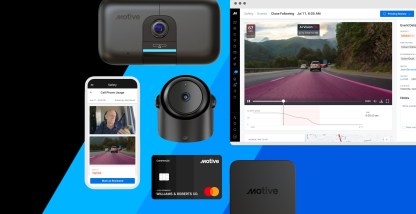Overseeing and organizing a fleet is complicated work, made more difficult by continuous changes in the industry. Fleet managers oversee route efficiency, driver and asset safety, vehicle maintenance, compliance, and sustainability — all while trying to satisfy customers and meet business objectives. All this leaves managers looking for fleet management strategies to simplify and streamline their work. These four top approaches can support fleet success and drive long-term growth.
1. Integrate fleet management
Integrating fleet management systems into a single solution empowers fleet managers with real-time visibility into daily operations. Save time and make informed, data-driven decisions by leveraging information about vehicle location, fuel consumption, maintenance schedules, driver behavior, and more — all from one dashboard. With this visibility, fleet managers can optimize routes, improve fuel efficiency, and respond promptly to any issues or emergencies. The ability to monitor driver behavior, such as speeding or harsh braking, and take appropriate action, also supports safer driving practices.
Fleet management solutions may offer streamlined communication benefits as well. With Motive fleet management, dispatchers, drivers, maintenance personnel, and managers can access real-time information, exchange messages, and collaborate more effectively. This can lead to improved coordination, reduced downtime, and enhanced customer service.
Integrating disparate fleet management systems can also enhance efficiency in the back office. With software consolidating data from different sources, managers can automate data entry, eliminate manual tasks, and reduce the potential for errors. Compliance-related tasks can also be streamlined, such as monitoring hours of service, driver qualification files, and vehicle inspection records to minimize compliance risks.
Integration can lead to significant cost savings as well. With improved visibility, managers can optimize fleet operations and support cost-effective maintenance programs to reduce fleet expenses and improve fuel efficiency.
Further, integrated fleet management systems offer scalability and flexibility. They’re designed to grow with a fleet, providing the ability to add or remove vehicles, customize features, and adapt to changes in operations without disrupting the overall system.
Choosing the right fleet management solution
A reliable fleet management solution offers several advantages to improve overall fleet performance. Thoroughly evaluate potential solutions based on the following factors:
- Experience and reputation. Look for a vendor with a proven track record and experience in fleet management.
- Range of services. Ensure the fleet management software can handle your specific needs around maintenance, fuel management, telematics, driver management, and reporting for seamless end-to-end fleet management.
- Customization and flexibility. Each organization’s requirements may differ, so ensure the fleet management software can accommodate your specific goals.
- Comprehensive data and analytics. Integration can provide access to valuable insights into fleet performance. Select a tool that simplifies data-driven decisions by enabling you to identify areas for improvement, set performance benchmarks, and measure the effectiveness of your fleet management strategies.
- Communication and support. Partner with a solution provider that values strong communication and is reliably available to address any concerns or issues.
2. Focus on driver training programs
Driver training plays a crucial role in promoting safety, reducing accidents, improving fuel efficiency, and enhancing overall fleet performance.
Creating effective driver training and coaching programs helps instill safe driving behaviors and practices by equipping fleet drivers with the necessary skills and knowledge to navigate various road conditions, handle emergencies, and follow traffic laws.
Well-trained drivers are more aware of potential hazards and less prone to accidents. Ensuring fleet drivers are aware of and comply with safety standards mitigates the risk of fines, penalties, and potential legal liabilities as well.
Further, using driver training to promote a safety culture can lead to lower insurance costs, reduced vehicle downtime, and improved overall fleet safety. Simultaneously, driver training programs often focus on avoiding aggressive acceleration and hard braking, maintaining optimal speeds, and minimizing idle time. All these contribute to fuel-efficiency, which can reduce fleet fuel and vehicle maintenance costs while also lowering carbon emissions.
Supporting driver training program success
To ensure the success of a driver training program, efforts should first focus on a fleet’s needs, industry, and operational challenges. Fleet managers might use telematics data to hone in on vehicle type, driving conditions, route, or other unique factors to customize training to effectively address specific skills and knowledge drivers need.
Make training ongoing to help drivers stay current and continuously improve. Fleets with driver scoring systems could incentivize safer driving by rewarding those who consistently demonstrate safe driving practices and achieve fuel efficiency targets. The scoring can also help fleet managers identify drivers who would benefit from additional coaching.
Offering after-trip coaching tailored to a particular driving behavior can also engage drivers and enhance learning retention. Dash cams can provide another layer of safety, and support more effective driver coaching programs. Using a clip of a critical safety event — such as hard braking, hard cornering, or excessive acceleration — can speak specifically to what that individual driver was doing and how to counter driving risky behaviors.
3. Prioritize route optimization
Creating the most efficient routes can be challenging for the human fleet manager. Yet, route optimization software can efficiently and accurately consider multiple factors such as traffic conditions, vehicle capacities, delivery/pickup time windows, and driver availability.
Optimized routes reduce unnecessary mileage, minimize idle time, and improve overall fleet productivity. This can result in fuel consumption cuts, lower vehicle wear and tear, and reduced labor costs. These reductions also contribute to environmental sustainability by lowering the fleet’s carbon footprint.
Eliminating unnecessary detours, optimizing delivery sequences, and minimizing empty miles, can also net significant cost savings in fuel expenses, maintenance, and driver overtime.
At the same time, customer satisfaction grows with improved, on-time performance. Reliability builds stronger customer relationships.
Advanced route optimization software often incorporates real-time data and dynamic routing capabilities. This enables fleets to adapt quickly to unexpected changes, such as traffic congestion, road closures, or last-minute customer requests — improving overall fleet responsiveness.
Choosing your route optimization software
The right route optimization software can streamline operations, improve efficiency, reduce costs, and enhance customer satisfaction. When selecting a route optimization solution, look for the following:
- Features such as address geocoding, multi-stop optimization, real-time traffic updates, and route customization
- Integration with other fleet management systems
- Ability to handle the size and complexity of your fleet operations
- Flexibility to accommodate various fleet types and industries
- Intuitive and user-friendly interface
- Analytical capabilities and reporting functionalities
- Data visualization tools
- Quality customer service
4. Track KPIs
Key performance indicators (KPIs) can play a crucial role by providing measurable metrics to assess and track the performance of your fleet. Every fleet will track its own individual key KPIs to gauge fleet efficiency. Yet the following are four common fleet management metrics.
Fuel Efficiency
Metrics a fleet manager might track to better understand and improve fleet fuel efficiency include:
- Fuel consumption per mile/kilometer. Measuring the amount of fuel consumed by a vehicle for a given distance traveled helps track and compare fuel efficiency across a fleet and pinpoint opportunities for improvement.
- Miles/ kilometers per gallon. Calculating the distance a vehicle can travel on one gallon or liter of fuel allows managers to assess and compare different vehicles or drivers to optimize routes, and identify fuel-wasting behaviors.
- Idling time. Tracking the percentage of time a vehicle spends idling can significantly impact fuel consumption.
Vehicle Downtime
By monitoring and analyzing vehicle downtime KPIs, fleet managers can identify areas for improvement, optimize maintenance processes, implement proactive measures, and ultimately reduce vehicle downtime. Regularly reviewing the following metrics may minimize operational disruptions:
- Vehicle use. Measuring the percentage of time a vehicle is actively used helps identify underutilized vehicles or potential overcapacity situations. This KPI can help to optimize fleet size, reduce downtime, and improve operational efficiency.
- Average vehicle downtime. Calculating the average time a vehicle spends off-road or out of service helps identify maintenance issues, improve maintenance planning, and minimize disruptions.
- Planned maintenance compliance. By evaluating the percentage of vehicles that undergo scheduled maintenance as per the manufacturer’s recommendations or fleet management guidelines, fleet managers may identify trends. This may help prevent breakdowns, extend the lifespan of vehicles, and minimize unexpected downtime.
Driver Safety
Driver safety is a priority for fleets. Confirm you’re doing all you can to support road safety by tracking key KPIs in this area. This may include:
- Accident frequency rate. Measuring the number of accidents or collisions per vehicle or driver over a specific period helps evaluate driver and vehicle safety performance to identify high-risk areas.
- Driver violations. This KPI assesses the number and type of traffic violations committed by drivers, such as speeding tickets or reckless driving. This can help identify potential safety risks, opportunities for corrective actions, and enhance driver training programs.
- Driver safety score. Quantifying driver performance based on various safety-related factors, including speeding, harsh braking, rapid acceleration, and seatbelt usage, and assigning a score to each driver opens the possibility to compare and benchmark driver performance, identify high-risk drivers, and tailor coaching or training programs to promote safer driving behaviors.
Vehicle Maintenance Costs
Effective vehicle maintenance optimizes productivity. Monitoring the following KPIs can help reduce costs and cut downtime:
- Maintenance costs per vehicle. Measuring the average cost of maintenance and repairs per vehicle over a specific period helps track maintenance expenses and evaluate the effectiveness of maintenance programs.
- Preventive maintenance compliance. Assessing the percentage of vehicles undergoing scheduled preventive maintenance may help reduce breakdowns and extend vehicle lifespans.
- Mean time between failures (MTBF). MTBF measures the average time a vehicle operates without experiencing a significant failure or breakdown. Tracking MTBF helps assess vehicle reliability, identify recurring issues, and optimize maintenance schedules.
Integrated fleet management systems support success
Implementing an integrated fleet management system, enhancing driver training programs, and pursuing route optimization opportunities can promote safety, improve customer service, increase profitability, and support sustainable business practices. Keeping track of it all with KPIs helps hold fleet managers and drivers accountable.
Fleet management software provides the real-time insights, automation, and analytics fleet managers need to make data-driven decisions and optimize operations. Contact a sales rep to get started today, or get a tour to see how Motive’s fleet management system can work for you.










